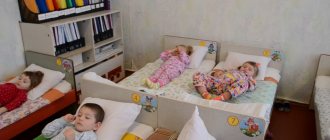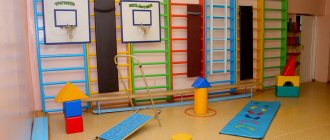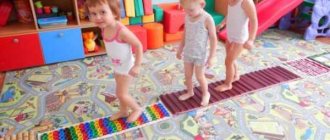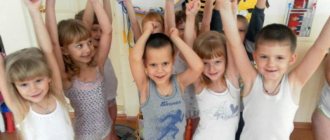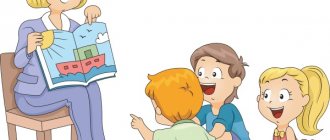Gymnastics for waking up after a nap in the middle group
Gymnastics for waking up after a nap in kindergarten.
Middle group Author: Nadezhda Nikolaevna Trunicheva, teacher, School 947, Moscow. Description of material: I offer you gymnastics for waking up after a nap for preschool children. This material will be useful to teachers of all age groups and physical education directors of kindergartens. Quiet time is an integral part of the daily routine of preschool children. After it, children wake up rested and with new strength. It is important to gradually include children in active activities, moving them from a state of inhibition to wakefulness. But each child has his own characteristics of awakening. Some children get up after a nap cheerful and cheerful. Others remain half asleep for a long time. Awakening gymnastics in kindergarten is precisely designed so that children of any age can painlessly, without tears and whims, move from daytime sleep to full-fledged play activities. Gymnastics after a nap helps the child’s body wake up, improves mood, and improves muscle tone. It is aimed at the gradual transition of children from sleep to wakefulness. During gymnastics, musical accompaniment is advisable. Music has a positive effect on children's emotions, creates a good mood in them, instills cheerfulness and joy, helps the rhythm of movements, and makes them easier to perform. Gymnastics (Greek gymnastike, from gymnazo - I train, exercise) is a system of specially selected physical exercises, methodological techniques used to improve health, improve a person’s motor abilities, strength, agility, endurance. These exercises allow you to influence either the entire body or promote the development of individual muscle groups and organs. Next, I offer you several awakening gymnastics complexes. 1st complex 1. “Stretch”. Starting position: lying on your back, arms along your body, stretching. 2. Starting position: lying on your back, arms along your body, inhale, sit with straight legs, hands to your toes, exhale, inhale, starting position. 3. Starting position: standing, feet shoulder-width apart, hands below, inhale, exhale, tilt the torso forward, inhale, starting position, exhale, tilt. 4. Starting position: standing, feet shoulder-width apart, arms below, inhale, arms to the sides, exhale, tilt the torso to the right, inhale, exhale, tilt the torso to the left. 5. Starting position: standing, feet shoulder-width apart, hands behind your head, inhale - rise on your toes, exhale - squat. 6. Starting position: standing, feet shoulder-width apart, arms along the body, inhale, arms through the sides up, rise on your toes, exhale, starting position. 2nd complex 1. Starting position: lying on your back, arms along the body. Bend your knees, pull your legs to your chest, clasp your knees with your hands, return to the starting position. 2. Starting position: lying on your back, hands behind your head, legs bent at the knees. Tilt your knees to the left, to the starting position, tilt your knees to the right, to the starting position. 3. Starting position: sitting, legs together, arms supported at the back. Bend your knees, pull them to your chest, with the sound “f-f” - exhale, starting position, inhale (through the nose). 4. Starting position: sitting, legs together, one hand on the stomach, the other on the chest. Inhale through the nose, drawing in the stomach; exhale through the mouth, inflating the stomach. 5. Starting position: standing, legs apart, arms down. Clap your hands - exhale; spread your palms to the sides - inhale. 6. Starting position: standing, legs apart, arms down. Stretching: reached to the ceiling, returned to the starting position. 3rd complex 1. Starting position: lying on your back, arms along the body, raise your arms up, stretch, arms forward, starting position. 2. Starting position: lying on your back, arms along your body, pull your toes towards you, starting position. 3. Starting position: sitting, legs straight, arms supported at the back, toes spread to the sides, starting position. 4. Starting position: sitting, legs straight, arms supported behind you, stepping with your toes, bending your knees, the same with straightening your legs. 5. Starting position: sitting, legs bent, arms supported behind your back, toes on your toes, left heel hitting the floor. 6. Starting position: standing, feet together, hands on waist, roll from toes to heels. 4th complex 1. “Stretch”. Starting position: lying on your back, arms along the body, stretching, starting position. 2. "Slide". Starting position: sitting, legs straight, arms supported behind, resting on the hands and heels of the straightened legs, raise the pelvis up, hold, return to the starting position. 3. "Boat". Starting position: lying on your stomach, arms up, bend over (raise your upper and lower torso), hold, return to the starting position. 4. "Wave". Starting position: kneeling, hands on your belt, sit to the right of your heels, hands to the left, starting position, sit to the left of your heels, hands to the right, starting position. 5. "Ball". Starting position: standing, feet together, jumping on two legs and tossing the ball in front of you. 6. Starting position: standing, feet shoulder-width apart, torso muscles relaxed. In complete silence, children listen to their own breathing and determine which part of the body moves when inhaling and exhaling (stomach, chest, shoulders in waves), quiet breathing or noisy breathing. 5th complex 1. Starting position: lying on your back, arms along your body, raise your right leg (straight), starting position, raise your left leg (straight), starting position. 2. Starting position: lying on your back, hands in front of you “holding the steering wheel”, “riding a bicycle”, starting position. 3. Starting position: lying on your back, arms up, turn your torso to the right without lifting your feet from the floor, start position, turn your torso to the left, start position. 4. Starting position: lying on your back, hands behind your head, bring your elbows together in front (elbows touching each other) - exhale, starting position, elbows touching the floor - inhale. 5. Starting position: sitting, legs crossed, hands on the belt, arms out to the sides, inhale, exhale. 6. Starting position: standing, feet shoulder-width apart, arms along the body, take correct posture without visual control (eyes closed), repeat 3-4 times. 6th complex 1. Starting position: lying on your back, arms along the body, raise your arms up, stretch, arms forward, starting position. 2. Starting position: lying on your back, arms along your body, pull your toes towards you, starting position. 3. Starting position: sitting, legs straight, arms supported at the back, toes spread to the sides, starting position. 4. Starting position: sitting, legs straight, arms supported behind you, stepping with your toes, bending your knees, the same with straightening your legs. 5. Starting position: sitting, legs bent, arms supported behind your back, toes on your toes, left heel hitting the floor. 6. Starting position: standing, feet shoulder-width apart, hands on waist, roll from toes to heels. 7th complex 1. Starting position: lying on your back, arms along your body, tense your body, inhale, hold for a few seconds, relax, exhale. 2. Starting position: lying on your back, arms to the sides, fingers clenched into fists, cross your arms in front of you, exhale, spread your arms, return to the starting position, inhale. 3. Starting position: lying on your back, hands behind your head, raise your left leg straight, raise your right leg straight, keep them together, starting position (lower at the same time). 4. Starting position: lying on your back, hands resting on your elbows, bend over, lift your chest up, keep your head straight (3-5 seconds), return to the starting position. 5. Starting position: lying on your stomach, hands behind your head, bend over, hands to your shoulders, legs on the floor, hold, starting position. 6. Starting position: lying on your stomach, hands under your chin, bend over, placing emphasis on your forearms, neck stretched - inhale, exhale. 8th complex 1. Starting position: lying on your back, arms along the body, raise your arms up, stretch, starting position. 2. Starting position: sitting, legs crossed (lotus position), massage of the big toes, starting from the pad to the base. 3. Starting position: the same, massage the fingers - from the nails to the base with pressure (internal and external). 4. Starting position: sitting, legs crossed (lotus position), arms forward, massage-stroking the arms - from fingers to shoulder. 5. Starting position: sitting, legs crossed (lotus position), close your eyes tightly for 5 seconds, open, repeat 5-6 times. 6. Starting position: standing, feet shoulder-width apart, hands on waist, walking in place with high knees. 9th complex 1. Starting position: lying on your back; legs are straight. Bend your knees and straighten them. 2. Starting position: lying on your back, arms along your body. Stretch, performing involuntary body movements. 3 Starting position: lying on your stomach, hands under your chin. Alternately place your head on your right shoulder, then on your left. 4. Starting position: lying on your stomach, hands under your chin. Raise your legs and dangle them. 5. Starting position: sitting. Raise your legs with your knees bent and swing them. 6. Starting position: sitting, hands on knees. Inhale, hold your breath, exhale 10th complex 1. Starting position: lying on your back, arms bent at the elbows in front of you. Alternately bend and straighten your legs, touching your elbows to your knees. 2. Starting position: lying on your back, arms bent at the elbows, legs at the knees. Flounder like a bug 3. Starting position: lying on your back, arms along your body. Inflate your stomach like a ball, hold the position without breathing for 2-3 seconds. 4. Starting position: sitting, legs crossed, hands on knees. Bend to the knees - alternately to the right, left. 5. Starting position: lying on your stomach, hands under your chin. Alternately place your head on your right shoulder, then on your left. 6. Starting position: sitting, hands on knees. Inhale, hold your breath, exhale.
We recommend watching:
Corrective gymnastics for children of the middle group Gymnastics after sleep for children of the older group Rhythmic gymnastics for children with disabilities Gymnastics after sleep in the middle group. Card index
Similar articles:
Morning exercises in the second junior group in a playful way
Morning exercises in kindergarten in the preparatory group
Lesson summary for the middle group Topic: “Gymnastics after sleep”
Program content:
1. Promote the transition from sleep to wakefulness.
2. Promote health in children.
3. Cultivate an interest in gymnastics after sleep, the desire to lead a healthy lifestyle, and take care of your body.
4. Prevention of colds by influencing active points.
5. Cheer up children's spirits
Equipment: massage mats, rope, salt mats, walnuts, balloons, music.
Preliminary work: perform gymnastics every day after sleep.
Progress of the lesson.
The teacher quietly wakes up, stroking each child, the children sit on the crib.
Educator: Good afternoon! Is everyone awake? Today we are not guys, but we will become animals. Look around, what kind of trees grow in our room?
Children: Palm trees!
Educator: Yes, guys, these are palm trees. Where do they grow?
Children: In the jungle.
Educator: What animals live in the jungle?
Children: Elephants, tigers, monkeys, etc.
Educator: That's right, well done! And today you and I will be monkeys.
The monkeys woke up and stretched.
1. Stretching.
IP: - lying on your back.
Both legs are stretched forward with their heels, both arms along the body - 4-5 times.
Goal: to feel the pleasure of tension turning into relaxation (cleaning the central energy channel.
2. “Facial massage”
I.P.: - sitting cross-legged.
Stroke the forehead, cheeks, gently wash the eyes, pressing on the wings of the nose, move the fingers from the bridge of the nose to the nasal sinuses (30 sec.)
Goal: prevention of colds by influencing active points of the face.
3. Ear massage.
I.P.: - sitting cross-legged.
Smooth the ears along the edges, gently pull the ears up, down, to the sides (3-4 times in each direction)
Educator: The monkeys lay down on their backs and took it. First, they lifted the vine with their paws and lowered it behind their heads.
4. I.P.: - lying on your back.
Children with straight hands lower the vine behind their heads, then to their feet (4-5 times)
Purpose: exercise for the shoulder girdle.
Educator: The monkeys decided to warm their heels in the sun.
5. I.P.: - lying on your back.
Children put the vine on their stomach, raise their legs up, and make circular movements of their feet (5-6 times).
Purpose: exercise for the abdominal and hip muscles.
Educator: And then they wanted to ride on the back.
6. I.P.: - lying on your back
Children swing on their backs, hugging their knees.
Educator: Suddenly clouds came and it started to rain. The monkeys got bored and began to disperse the clouds.
7.I.P.: - sitting cross-legged.
Children sharply inhale air through their nose and exhale slowly through their mouth (6-7 times).
Purpose: exercise for the muscles of the lower back and legs.
Educator: Guys, stand on the mats (children stand on massage mats). Look, the sun rose to warm up, and the monkeys began to dance.
8. I.P.: - stand on mats.
Children stand on rugs and hold a vine. To the music, children perform free dance movements (30 seconds).
Purpose: exercise for the muscles of the lower back and legs.
Educator: They wanted nuts, and they began to carefully make their way along the forest paths.
9. Children walk on massage mats, along footprints, along a snake and through a salt mat. They reach a basket of nuts. Take one nut in your hands and roll it in your palms in a circular motion.
Educator: Now we are inflating balloons. We inhale air through our nose and exhale through our mouth (7-8 times).
10. I.P.: - standing.
Children inflate balloons.
Educator: Well done, guys! Now go wash and get dressed.
Summary of the open regime moment in the middle group. Invigorating gymnastics
Nadezhda Plastinina
Summary of an open regime moment in the middle group. Invigorating gymnastics
Awakening gymnastics.
• promote a gradual transition from sleep to wakefulness .
• consolidate the ability to walk along the paths of health, stepping with a full foot.
• continue to teach how to breathe correctly when performing breathing exercises (inhale through the nose, exhale through the mouth)
.
• harden the child’s body, strengthening the arches of the feet and its ligaments.
• preventive and massage tracks, audio recording of calm music.
• looking at illustrations from books, reading nursery rhymes, conversations with children, creative activities, parents making health paths.
• after a nap.
Exercises for different groups
Gymnastics after sleep in the younger group
Daytime sleep is longest in the younger group of kindergarten. It can be difficult for kids to wake up in a good mood. If they were in a deep sleep, they may not immediately realize where they are. Children cry, are capricious, refuse to get up, wash, or get dressed. Therefore, during the exercises, the emphasis is on the emotional component of gymnastics: the correct selection of music, speech accompaniment, harmonization of the general atmosphere of the lesson. The images that the teacher will create during the exercises should be attractive.
Set of exercises “Sunshine”
A ray of sunshine woke up in the sky, A ray of sunshine reached out to the window.
There, outside the window, twenty children lie together in cozy beds. (Children stretch while lying in bed)
Hey, wake up, girls, boys!
You need to wear a dress and pants! Where are your pens? (Raise their hands and shake them in turn)
Where are your legs?
(Raise their legs, take turns doing swings)
Now we’ll play with you a little!
Come on, imagine that summer has come: The city has woken up, Rubbing their eyes with their fists).
And the sun rose.
(Raise their arms above their heads and stretch).
That is great!
So, let's ride into the distance along the path on a bicycle! (Doing the “Bicycle” exercise)
We drove and drove... - We arrived at the mill!
(Doing the “Mill” exercise)
Then we went. We drove, we drove... - We arrived at the river.
Let's help your feet, Let's touch some water! (They get up from the cribs, lowering their legs one by one to the floor)
Ay, the water is cold!
Here is one leg... (They jump on the right leg)
But here is another leg, what a nimble one!
(They jump on their left leg)
We stood in the water, Swimmed, (I make movements with my hands imitating swimming) We dived... Oh, good!
(They do squats with their arms extended forward)
They stood up from heel to toe and walked out onto the sand together.
(On tiptoes they walk out of the bedroom into the common room, where massage mats have already been prepared)
They walked on sand - They stepped on pebbles.
Oh, it's hot! (They walk in place on rubber mats for 2 minutes)
And now we have risen,
(Converge in the center of the hall)
We hold hands together.
(Form a circle)
Stretched,
(Stretched),
Smiled.
(Smile at each other).
Finally we woke up!
Gymnastics after sleep in the middle group
Gymnastics for middle group students should include a larger number of exercises. It is aimed not only at the emotional unity of children, but also at the comprehensive improvement of the child’s body. Elements of breathing exercises are required. It is advisable to combine gaming techniques with a set of exercises to prevent visual impairment and posture.
